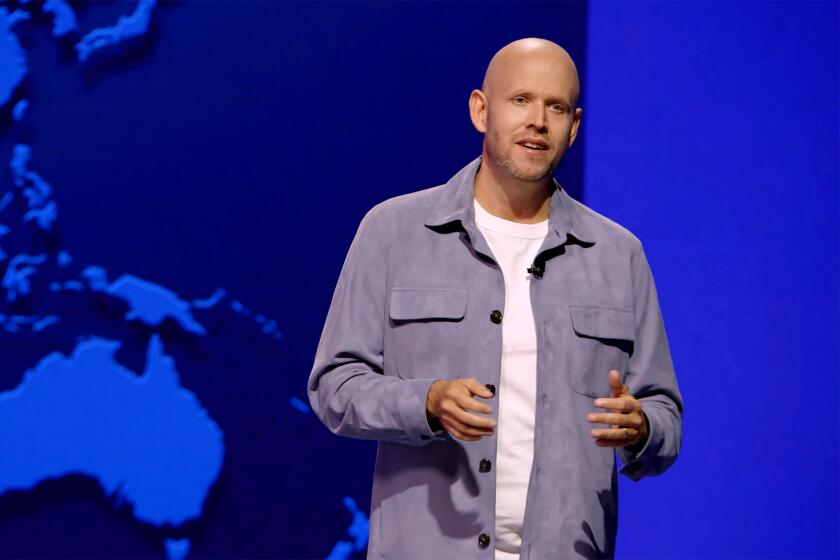Valley’s Aviation History Is Full of Soar Spots
Inscribed on a wall in a private jet terminal at Burbank Airport are the names of 36 test pilots for Lockheed’s famed Skunk Works.
Hailed as heroes, they were the first to fly some of the world’s most advanced military aircraft sculpted in secrecy at the Skunk Works from 1942 to 1992.
In Lockheed’s vast factories nearby, nearly 10,000 P-38 fighters were assembled for battle in World War II. Also born there were the P-80 Shooting Star, the U-2 spy plane and the SR-71 that still holds speed and altitude records three decades after its debut.
The inscriptions and photographs of test flights on the walls at Media Aviation “are a memorial to those guys at the Skunk Works,” said Robert H. Volk, company chairman. “They were all here at Burbank. All these planes were developed here,” he said.
Besides military aircraft, Lockheed’s Burbank workers also developed and produced highly advanced commercial aircraft such as the L-1011 wide-body airliner.
In short, the name Lockheed became synonymous with the aerospace industry that for decades dominated the San Fernando Valley and Southern California.
In 1959, Valley firms worked on a quarter of the country’s missiles and accounted for $3.85 billion in aircraft and missile hardware, according to Jackson Mayers in his 1976 chronicle, The San Fernando Valley. By the early 1960s, nearly 70% of the Valley’s one million residents were dependent on the defense and aerospace industries.
It all began in March 1928 when two brothers, Malcolm and Allan Loughead (who adopted an Americanized phonetic spelling of their Scottish-Irish name) decided they needed more space than their cramped Hollywood building to fill an order for 20 Lockheed monoplane aircraft.
They leased 20,000 square feet of factory space in a Burbank glass-manufacturing firm.
Lockheed became the driving force of the Southern California economy, thriving on the billions of dollars poured into the defense and aerospace industries and bringing with it housing and more jobs. At its wartime peak in 1943, Lockheed, camouflaged under vast tents of burlap, employed about 90,000 people, more than the population of Burbank.
Other names of the same era grew just as familiar. Among early designers for Lockheed was John K. Northrop, who continued to moonlight for the brothers even after he joined Donald Douglas, who himself had previously worked for Glenn Martin.
The dawn of aerospace emerged in the 1950s as firms sprang up throughout the Valley, playing key roles in developing rockets, missiles and man’s journey to the moon.
The rumble of test engines at the Rocketdyne Division of North American Aviation in Santa Susana Pass was readily heard, and ignored, throughout the Valley. Other major employers included Bendix Aviation, Ramo-Woolridge Laboratories, Litton Industries, RCA, Atomics International and Bunker-Ramo.
*
The seesaw route of aerospace in the following decades left behind a legacy of good times and bad. By the late 1980s, the fading dominance of aerospace was evident. Hughes Missile Systems, which was once the second largest employer in the Los Angeles area, shut down operations at its 86-acre site in West Hills in 1984. By 1992, the remnants of its California operations had moved from Canoga Park to Tucson.
Lockheed’s merger with Martin Aviation in 1989 marked the company’s gradual relocation out of Burbank to Georgia and elsewhere. The Skunk Works, with about 3,000 employees, moved into new facilities in Palmdale in the early 1990s, finally turning out the lights at the dilapidated Burbank facilities in 1994. The company still maintains a significant presence in California, with missile development operations in Sunnyvale and hundreds of other subsidiaries throughout the state.
Litton Industries, still based in Woodland Hills, is now the largest builder of nonnuclear ships for the U.S. Navy. More than 3,000 of the company’s 40,000 employees worldwide report to Valley subsidiaries that produce a variety of products, including navigation and guidance systems.
The Boeing Co.’s Rocketdyne Propulsion and Power division, responsible for research and development of defense and aerospace laser and electro-optics, announced this week that it is expanding its facilities at the West Hills Corporate Village.
Now, 70 years after the Loughead brothers migrated over the hill to the Valley, another migration to the north is underway: Lockheed, Boeing and Northrop all have operations in Palmdale.
To be sure, aerospace is not the major economic factor that it once was. But it is still significant: Boeing rolled out its prototype for the next generation warplane--the Joint Strike Fighter--last week, while Lockheed engineers labor on their own version of the plane less than a mile away.
More to Read
Inside the business of entertainment
The Wide Shot brings you news, analysis and insights on everything from streaming wars to production — and what it all means for the future.
You may occasionally receive promotional content from the Los Angeles Times.










